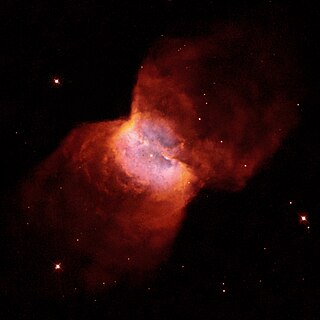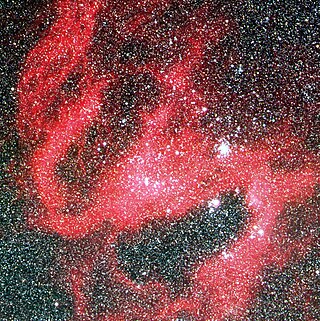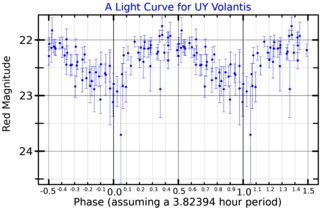
The Large Magellanic Cloud (LMC) is a dwarf galaxy and satellite galaxy of the Milky Way. At a distance of around 50 kiloparsecs (163,000 light-years), the LMC is the second- or third-closest galaxy to the Milky Way, after the Sagittarius Dwarf Spheroidal (c. 16 kiloparsecs (52,000 light-years) away) and the possible dwarf irregular galaxy called the Canis Major Overdensity. Based on the D25 isophote at the B-band (445 nm wavelength of light), the Large Magellanic Cloud is about 9.86 kiloparsecs (32,200 light-years) across. It is roughly one-hundredth the mass of the Milky Way and is the fourth-largest galaxy in the Local Group, after the Andromeda Galaxy (M31), the Milky Way, and the Triangulum Galaxy (M33).

NGC 2346 is a planetary nebula near the celestial equator in the constellation of Monoceros, less than a degree to the ESE of Delta Monocerotis. It is informally known as the Butterfly Nebula. The nebula is bright and conspicuous with a visual magnitude of 9.6, and has been extensively studied. Among its most remarkable characteristics is its unusually cool central star, which is a spectroscopic binary, and its unusual shape.

The Tarantula Nebula is a large H II region in the Large Magellanic Cloud (LMC), forming its south-east corner.

A stellar black hole is a black hole formed by the gravitational collapse of a star. They have masses ranging from about 5 to several tens of solar masses. They are the remnants of supernova explosions, which may be observed as a type of gamma ray burst. These black holes are also referred to as collapsars.

NGC 300 (also known as Caldwell 70 or the Sculptor Pinwheel Galaxy) is a spiral galaxy in the constellation Sculptor. It is one of the closest galaxies to the Local Group, and probably lies between the latter and the Sculptor Group. It is the brightest of the five main spirals in the direction of the Sculptor Group. It is inclined at an angle of 42° when viewed from Earth and shares many characteristics of the Triangulum Galaxy. It is 94,000 light-years in diameter, somewhat smaller than the Milky Way, and has an estimated mass of (2.9 ± 0.2) × 1010M☉.

S Doradus is one of the brightest stars in the Large Magellanic Cloud (LMC), a satellite galaxy of the Milky Way, located roughly 160,000 light-years away. The star is a luminous blue variable, and one of the most luminous stars known, having a luminosity varying widely above and below 1,000,000 times the luminosity of the Sun, although it is too far away to be seen with the naked eye.

NGC 1850 is a double cluster and a super star cluster in the Dorado constellation, located in the northwest part of the bar of the Large Magellanic Cloud, at a distance of 168 kly (51.5 kpc) from the Sun. It was discovered by Scottish astronomer James Dunlop in 1826.

An ultraluminous X-ray source (ULX) is an astronomical source of X-rays that is less luminous than an active galactic nucleus but is more consistently luminous than any known stellar process (over 1039 erg/s, or 1032 watts), assuming that it radiates isotropically (the same in all directions). Typically there is about one ULX per galaxy in galaxies which host them, but some galaxies contain many. The Milky Way has not been shown to contain a ULX, although SS 433 may be a possible source. The main interest in ULXs stems from their luminosity exceeding the Eddington luminosity of neutron stars and even stellar black holes. It is not known what powers ULXs; models include beamed emission of stellar mass objects, accreting intermediate-mass black holes, and super-Eddington emission.

WR 136 is a Wolf–Rayet star located in the constellation Cygnus. It is in the center of the Crescent Nebula. Its age is estimated to be around 4.7 million years and it is nearing the end of its life. Within a few hundred thousand years, it is expected to explode as a supernova.

NGC 1023, also known as the Perseus Lenticular Galaxy, is a barred lenticular galaxy, a member of the NGC 1023 group of galaxies in the Local Supercluster. Distance measurements vary from 9.3 to 19.7 million parsecs (30 to 64 million light-years). The supermassive black hole at the core has a mass of (4.4±0.5)×107 M☉. The black hole was discovered by analyzing the dynamics of the galaxy.

R136a1 is one of the most massive and luminous stars known, at nearly 200 M☉ and nearly 4.7 million L☉, and is also one of the hottest, at around 46,000 K. It is a Wolf–Rayet star at the center of R136, the central concentration of stars of the large NGC 2070 open cluster in the Tarantula Nebula in the Large Magellanic Cloud. The cluster can be seen in the far southern celestial hemisphere with binoculars or a small telescope, at magnitude 7.25. R136a1 itself is 100 times fainter than the cluster and can only be resolved using speckle interferometry.

AB7, also known as SMC WR7, is a binary star in the Small Magellanic Cloud. A Wolf–Rayet star and a supergiant companion of spectral type O orbit in a period of 19.56 days. The system is surrounded by a ring-shaped nebula known as a bubble nebula.
HD 38282 is a massive spectroscopic binary star in the Tarantula Nebula, consisting of two hydrogen-rich Wolf-Rayet stars.

NCG 5204 is a Magellanic spiral galaxy located about 14.5 million light-years away from Earth in the constellation of Ursa Major and is a member of the M101 Group of galaxies. It has a galaxy morphological classification of SA(s)m and is highly irregular, with only the barest indication of any spiral arm structure. The galaxy's most prominent feature is an extremely powerful X-ray source designated NGC 5204 X-1. This has resulted in the galaxy being the target of several studies due to the strength of the source and its relative proximity to Earth.
BAT99-98 is a Wolf–Rayet star located in the Large Magellanic Cloud, in NGC 2070 near the R136 cluster in the Tarantula Nebula. At 226 M☉ and 5,000,000 L☉ it is one of the most massive and luminous stars currently known.

NGC 6388 is a globular cluster of stars located in the southern constellation of Scorpius. The cluster was discovered by Scottish astronomer James Dunlop on May 13, 1826 using a 20 cm (9 in) reflector telescope. It was later determined to be a globular cluster by English astronomer John Herschel, who was able to resolve it into individual stars. NGC 6388 is located at a distance of approximately 35,600 light-years (10.90 kpc) from the Sun. Due to its apparent visual magnitude of +6.8, binoculars or a small telescope are required to view it.

UY Volantis, also known as EXO 0748-676, is a low mass X-ray binary system located in the constellation Volans. With an apparent magnitude of 16.9, it requires a powerful telescope to see. With a radial velocity of 20 km/s, it is drifting away from the Solar System, and is currently located 26,000 light years away.

VFTS 243 is an O7V type main sequence star that orbits a stellar mass black hole. The black hole is around nine times the mass of the Sun, with the blue star being 25 times the mass of the Sun making the star 200,000 times larger than the black hole. VFTS 243 is located in the Large Magellanic Cloud inside NGC 2070 around 160,000 light years from Earth. The binary has an orbital period of 10.4 days.
















